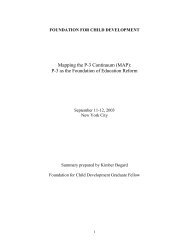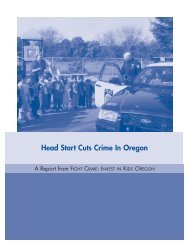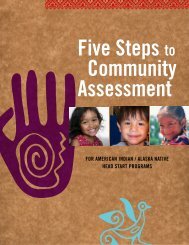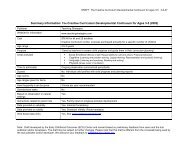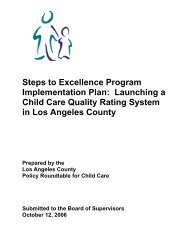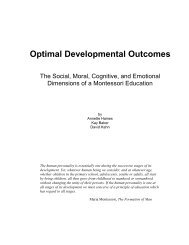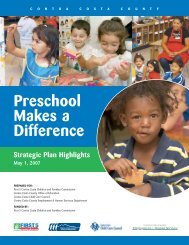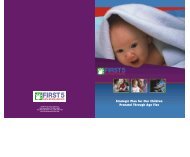California Preschool Planning Toolkit Budget and ... - Karen Hill Scott
California Preschool Planning Toolkit Budget and ... - Karen Hill Scott
California Preschool Planning Toolkit Budget and ... - Karen Hill Scott
You also want an ePaper? Increase the reach of your titles
YUMPU automatically turns print PDFs into web optimized ePapers that Google loves.
<strong>California</strong> <strong>Preschool</strong> <strong>Planning</strong> <strong>Toolkit</strong>Process7<strong>Budget</strong> <strong>and</strong>LaunchProjectionsNeedsFacilitiesSystemsEngagementProgramFinancebyA Project Funded by the David <strong>and</strong> Lucile Packard Foundation
<strong>Budget</strong> <strong>and</strong> Phase-InOVERVIEWThe goal of this section is to offer a practical method to estimate the local cost of implementing a qualitypreschool program accessible to all on a “system-wide” basis, such as within a county, city, or schooldistrict(s).The approach recommended here involves the use of a model originally developed by the Institute forWomen’s Policy Research (IWPR) <strong>and</strong> Early Childhood Policy Research (ECPR) for states to estimatethe cost of implementing universal preschool. The American Institutes for Research (AIR) adapted thismodel to the development of local cost estimates, as described in the First 5 <strong>California</strong> <strong>Preschool</strong> for All<strong>Toolkit</strong> <strong>and</strong> Developing a Local <strong>Preschool</strong> for All Plan located on the First 5 <strong>California</strong> website (see linksunder Resources).Although the complete model is composed of two categories, direct service costs <strong>and</strong> infrastructurecosts, this section focuses on the direct service costs likely to be encountered by preschoolimplementers locally. See Section 3 for how to estimate the cost of workforce development <strong>and</strong> Section 4for how to assess the cost of facilities.The model assumes that the majority of direct service costs related to program implementation will beupgrading the compensation of early education teachers as they obtain educational qualifications similarto those of elementary school teachers. Given current <strong>California</strong> policy as of the writing of this <strong>Toolkit</strong>, thegoal of this section is to help counties budget for improved quality of preschool, moving towards universalaccess with an incremental approach. The approach is incremental in two ways: First, the increase inteacher qualifications <strong>and</strong> compensation is phased in, because existing teachers cannot be expected toobtain bachelor’s or associate’s degrees overnight. Second, the approach is incremental because accessto new or upgraded preschool spaces takes place gradually, as resources are available to finance them.Developing a plan for phasing in preschool is thus an important part of the planning process. Samplephase-in plans are included in this <strong>Toolkit</strong> that extend five, eight, <strong>and</strong> ten years, but individual localitiesmay use the same approach to cover any time span. Since AB 172 will provide some funds forexp<strong>and</strong>ing preschool in attendance areas for low API schools (deciles 1-3), it is recommended thatcounties focus their plans on these areas first.Before costs can be estimated <strong>and</strong> a phase-in plan developed, a Needs Assessment (see Section 2)must be completed. Data from the needs assessment will be used to determine the number of new <strong>and</strong>upgraded spaces needed, <strong>and</strong> the areas with low API schools <strong>and</strong> a relatively greater need for newspaces. This data, along with the estimated per child cost of new <strong>and</strong> upgraded spaces can be used tocreate a budget, <strong>and</strong> ultimately to determine the length of time necessary to phase in access to a qualitypreschool program for all four-year-olds (the same model could be used to develop a plan that includedthree-year-olds as well). An accurate budget <strong>and</strong> well-thought-out phase-in plan are critical to thesuccess of a preschool initiative.The <strong>California</strong> <strong>Preschool</strong> <strong>Planning</strong> <strong>Toolkit</strong>: October 20061
<strong>Budget</strong> <strong>and</strong> Phase-InPRINCIPLES AND GUIDELINESThe principles <strong>and</strong> criteria below may help shape your program <strong>and</strong> budget development.Relevant <strong>Preschool</strong> <strong>California</strong> Principles:Financing Will Support the Cost of Quality ProgramsPrograms will be sufficiently funded to meet the real cost of a quality early childhood education. Thisincludes meeting established st<strong>and</strong>ards, providing comparable pay <strong>and</strong> benefits for qualified teachers,establishing accessible higher education opportunities for the preparation of the workforce, developingsuitable preschool facilities, <strong>and</strong> engaging in ongoing quality assessments. Financing of preschoolshould not detract from funding for infants, toddlers, <strong>and</strong> school-age children, or from child care subsidiesthat help low-income families to work.SAMPLE APPROACHES<strong>California</strong> Approaches:<strong>California</strong> has numerous examples of counties that are phasing in quality preschool. Los Angeles Countyhas developed a five star system quality rating system for preschool programs, with programs with threeto five stars eligible to apply to participate in Los Angeles Universal <strong>Preschool</strong> (LAUP), with more starsrepresenting higher quality, especially in teacher qualifications, <strong>and</strong> qualifying for a higher rate ofreimbursement. A description of the star system is included in the Quality section of this <strong>Toolkit</strong>, <strong>and</strong>reimbursement rates are included in this section.First 5 Power of <strong>Preschool</strong> (PoP) demonstration grants also offer three levels of reimbursement—Entry,Advancing <strong>and</strong> Full Quality. Tables showing current reimbursement rates from two PoP grant counties,San Francisco <strong>and</strong> San Mateo, are also included in this section.Experiences in Other States:Participation RatesIn Oklahoma <strong>and</strong> Georgia, the only two states that have fully implemented voluntary universal preschool,participation rates are around 70 percent in the publicly funded preschool program <strong>and</strong> collaboratingHead Start programs. However, the total enrollment of four-year-olds in some kind of formal earlyeducation <strong>and</strong> care, including private programs unaffiliated with the state preschool program, is estimatedto be higher, <strong>and</strong> participation also varies by county.The <strong>California</strong> <strong>Preschool</strong> <strong>Planning</strong> <strong>Toolkit</strong>: October 20062
<strong>Budget</strong> <strong>and</strong> Phase-InExpenditures per ChildState expenditures for preschool vary substantially, based on teacher qualifications, teachercompensation, <strong>and</strong> program duration. For a rating of states on reimbursement levels, see the State<strong>Preschool</strong> Yearbook published by the National Institute for Early Education Research (link included in theresource list below).BASIC ISSUES AND INSTRUCTIONSBelow is a brief list of the basic instructions for estimating the cost of preschool in your county:1. Underst<strong>and</strong> the current budgets of existing publicly-funded preschool providers, such as State<strong>Preschool</strong> <strong>and</strong> Head Start. Create “before” budgets.2. Determine the teacher qualifications you want.3. Determine teacher salaries. Counties often use beginning K-12 salaries or average kindergartenteacher salaries.4. Set teacher/child ratios.5. Using the above teacher qualifications, ratios, <strong>and</strong> salaries, create “after” budgets: the full cost ofa preschool program that meets your PFA st<strong>and</strong>ards.6. For existing public programs who will participate, calculate the difference in cost per childbetween the “before” <strong>and</strong> “after” budgets.7. Determine the number of children you project will participate in the PFA program in your county.8. Determine the number of children already served in existing participating programs (from yourneeds assessment sheet).9. Calculate cost of full implementation.10. Develop a feasible phase-in plan, by gradually ramping up teacher salaries <strong>and</strong>/or participationrates.For more complete instructions, see “How to Estimate a <strong>Budget</strong> <strong>and</strong> Phase-In Plan” in the Tools<strong>and</strong> Templates section in the materials in this section of the <strong>Toolkit</strong>.TOOLS AND TEMPLATES1. How to Estimate a <strong>Budget</strong> <strong>and</strong> Phase-In PlanOTHER RESOURCES1. Examples of provider budgets (included)2. Examples of phase-in plans (included)3. Examples of tiered reimbursement rates (included)4. County-specific data on certificated salaries by school district available athttp://www.cde.ca.gov/ds/fd/cs/documents/j90summary0405.doc or interactively at http://www.ed-The <strong>California</strong> <strong>Preschool</strong> <strong>Planning</strong> <strong>Toolkit</strong>: October 20063
<strong>Budget</strong> <strong>and</strong> Phase-Indata.k12.ca.us/navigation/fstwopanel.asp?bottom=/fiscal/fundingsummary.asp%3Flevel%3D06%26fyr%3Dcurrent%26reportnumber%3D45. <strong>Preschool</strong> for All: Step by Step, A <strong>Planning</strong> Guide <strong>and</strong> <strong>Toolkit</strong>, Section 4: Estimating the LocalCost of <strong>Preschool</strong> for All; developed by American Institutes for Research for First 5 <strong>California</strong>;http://www.ccfc.ca.gov/PDF/SRI/Section4.pdf6. Developing A Local <strong>Preschool</strong> for All Plan; developed by American Institutes for Research forFirst 5 <strong>California</strong>; http://www.ccfc.ca.gov/PFA.htm7. Orchestrating Access to Affordable, High-Quality Early Care <strong>and</strong> Education for All YoungChildren, Human Services Policy Center, University of Washington, 2004;http://www.hspc.org/publications/pdf/OrchestratingReport.pdf8. How Much Does Quality <strong>Preschool</strong> Cost? W. Steven Barnett & Kenneth B. Robin, NationalInstitute for Early Education Research, 2006, athttp://nieer.org/resources/research/CostOfEffective<strong>Preschool</strong>.pdf9. The 2005 State <strong>Preschool</strong> Yearbook, the National Institute for Early Education Research.Rutgers, the State University of New Jersey. http://nieer.org/yearbook/The <strong>California</strong> <strong>Preschool</strong> <strong>Planning</strong> <strong>Toolkit</strong>: October 20064



